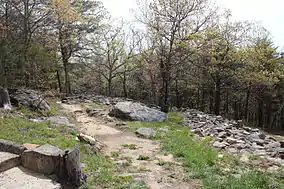Fort Mountain State Park
Fort Mountain State Park is a 3,712-acre (15.02 km2) Georgia state park located between Chatsworth and Ellijay on Fort Mountain. The state park was founded in 1938 and is named for an ancient 885-foot-long (270 m) rock wall located on the peak.[1] The nomination form for the National Register of Historic Places describes the wall as "more of a marker than a fortification, separating the north peak from the southern end."[2]
| Fort Mountain State Park | |
|---|---|
 View of the ruins | |
 Location of Fort Mountain State Park in Georgia | |
| Location | Murray County, Georgia, USA |
| Nearest city | Ellijay, Georgia |
| Coordinates | 34°45′39″N 84°42′26″W |
| Area | 3,712 acres (15.02 km2) |
| Governing body | Georgia State Park |
History
Fort Mountain State Park officially opened in 1936 on land donated by Ivan Allen, Sr. The park was originally 1,930-acre (7.8 km2). The Civilian Conservation Corps built many of the park's facilities, such as the stone fire tower, the lake, the trails and some park buildings. With help from state and federal funding, the park expanded its boundaries during the late 1990s to 3,712-acre (15.02 km2).[1]
Ancient wall
The state park derived its name from an ancient 885-foot-long (270 m) rock wall located on the peak. The zigzagging wall contains 19[3] or 29[4] pits scattered along the wall, in addition to a ruin of a gateway. The wall was constructed out of local stones from the surrounding regions around the summit. A 1956 archaeological report concluded only that the structure "represents a prehistoric aboriginal construction whose precise age and nature cannot yet be safely hazarded until the whole problem, of which this is a representative, has been more fully investigated,"[3] while a modern online tourist website states that the wall was built by local Native Americans around 500 AD for religious purposes.[5]
There are several legends concerning the wall. One legend claims that the wall is a remnant of one of the several stone forts legendary Welsh explorer Madoc and his group built throughout the present-day United States. The wall has also been related to the "moon-eyed people" of Cherokee lore.[5] Other speculations of the wall's origins and purposes have included a fortification for Hernando de Soto's conquistadors and a honeymoon haven for Cherokee newlyweds.[3][4]
Description
Situated in the Chattahoochee National Forest, Fort Mountain State Park offers many outdoor activities, such as hiking, mountain biking, and horseback riding. There are 14 miles (23 km) of trails inside the park.[6] The park is also known for its unique scenery, a mixture of both hardwood and pine forests and several blueberry thickets. In addition, the park contains a 17-acre (6.9 ha) mountain lake. Atop Fort Mountain itself is a tower constructed by members of the Civilian Conservation Corps (CCC). The picnic shelters in the park and the trails to the rock wall were also constructed by the CCC.[1]
The summit of a different mountain in the south-southwest part of the park contains a radio tower for Georgia Public Broadcasting, transmitting TV station WCLP-TV (now WNGH-TV) since 1967, and radio station WNGH-FM since about May 2008.
The park is accessible via Woody Glenn Highway (Georgia 2 and Georgia 52).
Gallery

Fort Mountain overlook 
Another view of the ruins 
View from Fort Mountain 
The stone tower 
The Fort Mountain lake 
A trail inside the park
See also
References
- Fort Mountain State Park. Georgia Public Broadcasting. Retrieved 21 March 2012.
- "National Register of Historic Places Nomination form". United States Department of the Interior. January 1977. Retrieved 5 December 2019.
- Smith, Philip E., "Aboriginal Stone Constructions in the Southern Piedmont", in University Of Georgia Laboratory Of Archaeology Series Report No 4 1962 Archived 2013-06-16 at the Wayback Machine
- Mystery Shrouds Fort Mountain. The Historical Markers Database. 18 September 2009. Retrieved 21 March 2012.
- Fort Mountain State Park. ngeorgia.com. Retrieved 21 March 2012
- Fort Mountain State Park. GeorgiaTrails.com. Retrieved 21 March 2012.
External links
| Wikimedia Commons has media related to Fort Mountain State Park. |